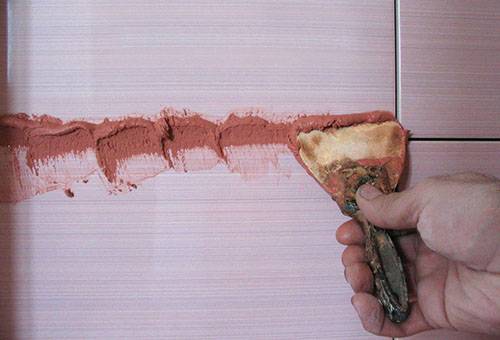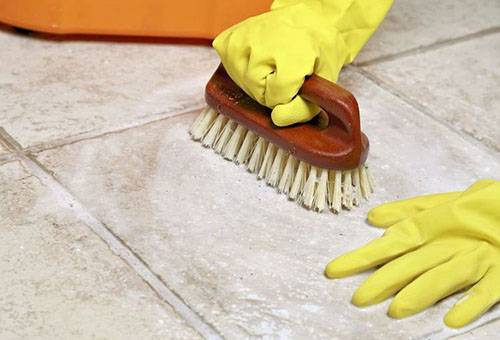How and with what can you wash tiles and porcelain tiles after renovation?
The joy of finishing renovations in the bathroom and kitchen is overshadowed by the need to remove all construction debris and dust remaining after the work.

Types of pollution
What can get on tiles and porcelain tiles during the repair process:
- cement;
- sealant;
- paints;
- polyurethane foam;
- gypsum;
- putty;
- plaster;
- tile adhesive;
- primer;
- grout for tile joints.
Almost always, these substances and building mixtures can be removed from the surface of the tile simply with a damp cloth, if you do this in fresh traces before they have time to harden. Old stains are much more difficult to remove.
To remove all these contaminants remaining after repairs, there are specialized household chemicals. But, as a rule, you can get by with simpler and less expensive folk methods. It will be easiest to clean a glossy, smooth surface. If the porcelain tile is matte, porous or has a small relief, then the dust can penetrate deeply into it, and it will not be easy to remove it completely.
How to clean porcelain tiles?
If the craftsmen worked carefully and removed all dirt using fresh traces, then cleaning after the repair will not cause any special problems. Only construction dust will have to be washed off. First you will need to collect large debris and sweep the tiles. But for fine dust that cannot be removed with a broom, it is enough to wipe the tiles with water, to which you can add any mild detergent, soap, toothpaste or powder.The rag or sponge you use should be rinsed frequently in water, the tile should be washed several times, and at the end it is better to wipe it dry so that there are no streaks left on the tile.
But there are other means.
- Alcohol-containing window sprays will help you clean the tiles well and avoid streaks.
- Water with the addition of lemon juice or essential oil cleans the surface well, and also gives it shine and a pleasant aroma.
- You can also make the tiles shine by wiping them with an aqueous solution of vinegar.
- Ordinary felt polishes and cleans glossy tiles well.
Advice
It is recommended to test any aggressive cleaning agent for its effectiveness and safety on porcelain tiles somewhere in an inconspicuous place and only then try to wash the entire room with it.
Removing dried building mixtures
You can try to remove any such substances from the surface of porcelain tiles mechanically - with some sharp object, a construction float or sandpaper. However, there is a risk of damaging the glazed coating of the tiles, so it is better to resort to alternative methods.
- It is recommended to first soak the tile adhesive, if possible, by placing a damp cloth on it, and only then try to wipe it off. For polymer adhesives, a rag is moistened with solutions of vinegar, ammonia or acetone. Only a solvent is truly effective against epoxy glue; folk remedies are unlikely to help.
- Lumps of cement, putty, etc. stuck to the floor during repairs can also be removed mechanically. You can scrape them with a knife, old scissors, or a metal or plastic spatula. Large pieces can be easily separated from porcelain stoneware even just by hand.
- But scraping off the paint is much more difficult. It is better to dissolve it with substances intended specifically for this type of paint. Water-based dyes can be easily removed with a damp cloth, while acrylic and oil dyes can be removed with solvents such as White Spirit. If the stain is old enough and cannot be wiped off the first time, it is recommended to place a cloth soaked in solvent on it for a while.
- To make it easier to wipe off the grout after repairs, wetting the tiles before grouting the tile joints will help. In addition, it is much easier to remove from tiles with a smooth surface. You should first try to remove stubborn grout simply with a damp cloth or hard sponge, and if this does not help, use any acid-containing liquids and powders. These can be either household chemicals or self-prepared acid solutions. But on some types of tiles, for example, those with a metallized surface, such products can leave light spots.
- Whitewash is removed from porcelain tiles in several stages. To begin with, rinse it abundantly with water, then wipe particularly contaminated areas with a sponge and detergent, and then rinse it thoroughly.
If the tile glaze is thick enough, then you can use any abrasive detergents and even ordinary soda without fear for its integrity. They are effective even against stubborn dirt, since they act on them mechanically.
When choosing a cleaning agent for cleaning, you should remember that all solvents, acidic, alkaline or chlorine-containing preparations are very aggressive for the skin, so you need to work with them wearing gloves and closed clothing.

